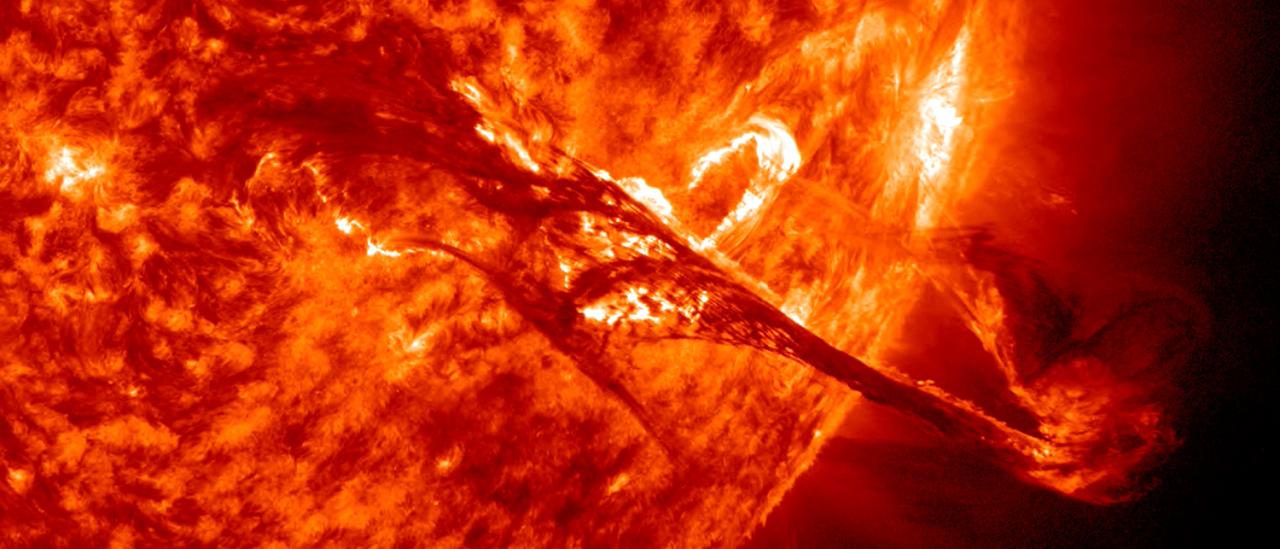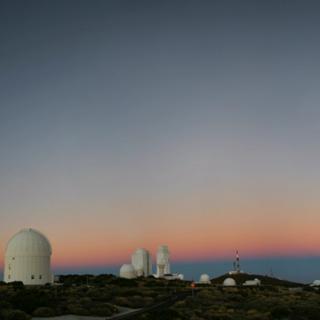General
Magnetic fields are at the base of star formation and stellar structure and evolution. When stars are born, magnetic fields brake the rotation during the collapse of the mollecular cloud. In the end of the life of a star, magnetic fields can play a key role in the form of the strong winds that lead to the last stages of stellar evolution. During the whole adult life of a star, magnetic fields are the origin of stellar activity. Our Sun has magnetic fields that give rise to such spectacular activity that impacts the climate on Earth. The magnetic activity in other stars is, in some cases, of orders of magnitude more intense than the solar one, influencing – often drastically – the transport of chemical species and angular momentum, as well as affecting the possible planetary systems around them.
The aim of this project is the study of the diverse manifestations of the magnetic field that can be observed in the solar atmosphere and in other stars. These include distinct structures as sunspots, weak quiet-sun fields or chromospheric and coronal features such as filaments and prominences. The following research topics have been gradually faced:
Solar magnetism
1. Structure and evolution of Sunspot magnetic fields.
2. Structure and evolution of quiet Sun magnetic fields.
3. Structure and evolution of the magnetism of the chromosphere and of chromospheric strcutures (promiences, spicules,...)
4. Structure and evolution or coronal loops.
5. Structure and evolution of the Sun's global field. Studies of the activity cycle.
6. Empirical study of propagation of magnetohydrodynamic waves in magnetic structures.
7. Empirical study of energy transfer mechanisms related with the heating of the external atmospheric layers.
8. Empirical study of the influence of partial ionisation in the dynamics of the solar atmosphere.
9. Participation in the European Solar Telescope project.
Stellar magnetism
1. Development of numerical tools to diagnose stellar magnetic fields, both in the surface and in the chromsphere.
2. Study of magnetic fields in stellar prominences.
3. Study of the role of magnetic fields in the late stages of stellar evolution.
Members
Results
- Spiral waves in sunspots: They have been interpreted as magnetoacoustic waves propagating from the interior to the atmosphere following the direction of the magnetic field. We have characterized the magnetic field topology, dismissing the twist of the field lines as the cause of the spiral shape (Felipe et al. 2019).
- Magnetic response to umbral flashes: Simultaneous spectropolarimetric observations of the chromospheric He I 10830 and Ca II 8542 lines have been used to estimate the fluctuations of the magnetic field associated to shock waves. The shocks cause expansion of the magnetic field lines (Houston et al. 2018, including A. Asensio Ramos).
Scientific activity
Related publications
-
Modeling the thermal conduction in the solar atmosphere with the code MANCHA3D
Context. Thermal conductivity is one of the important mechanisms of heat transfer in the solar corona. In the limit of strongly magnetized plasma, it is typically modeled by Spitzer's expression where the heat flux is aligned with the magnetic field. Aims: This paper describes the implementation of the heat conduction into the code MANCHA3D with an
Navarro, A. et al.Advertised on:
72022 -
Comparative study of Shack-Hartmann configurations for atmospheric turbulence reconstructions in solar adaptive optics
The correction of the phase variations induced by the atmospheric turbulence is one of the most complex problems that an Adaptive Optics (AO) System must deal with, as it must calculate the properties of all the atmosphere traversed by the light from several measures taken by ground-based telescopes. Traditional reconstructors systems used in AO
Riesgo, Francisco García et al.Advertised on:
112022 -
Generalized Fluid Models of the Braginskii Type
Several generalizations of the well-known fluid model of Braginskii (1965) are considered. We use the Landau collisional operator and the moment method of Grad. We focus on the 21-moment model that is analogous to the Braginskii model, and we also consider a 22-moment model. Both models are formulated for general multispecies plasmas with arbitrary
Hunana, P. et al.Advertised on:
62022 -
Solar Hα excess during Solar Cycle 24 from full-disk filtergrams of the Chromospheric Telescope
Context. The chromospheric Hα spectral line is a strong line in the spectrum of the Sun and other stars. In the stellar regime, this spectral line is already used as a powerful tracer of stellar activity. For the Sun, other tracers, such as Ca II K, are typically used to monitor solar activity. Nonetheless, the Sun is observed constantly in Hα with
Diercke, A. et al.Advertised on:
52022 -
Construction of coronal hole and active region magnetohydrostatic solutions in two dimensions: Force and energy balance
Coronal holes and active regions are typical magnetic structures found in the solar atmosphere. We propose several magnetohydrostatic equilibrium solutions that are representative of these structures in two dimensions. Our models include the effect of a finite plasma-β and gravity, but the distinctive feature is that we incorporate a thermal
Terradas, J. et al.Advertised on:
42022 -
DeSIRe: Departure coefficient aided Stokes Inversion based on Response functions
Future ground-based telescopes, such as the 4-metre class facilities DKIST and EST, will dramatically improve on current capabilities for simultaneous multi-line polarimetric observations in a wide range of wavelength bands, from the near-ultraviolet to the near-infrared. As a result, there will be an increasing demand for fast diagnostic tools, i
Ruiz Cobo, B. et al.Advertised on:
42022 -
Accelerating Non-LTE Synthesis and Inversions with Graph Networks
The computational cost of fast non-LTE synthesis is one of the challenges that limits the development of 2D and 3D inversion codes. It also makes the interpretation of observations of lines formed in the chromosphere and transition region a slow and computationally costly process, which limits the inference of the physical properties on rather
Vicente Arévalo, A. et al.Advertised on:
42022 -
Enhanced Channel Calibration for the Image Sensor of the TuMag Instrument
The Sunrise missions consist of observing the magnetic field of the sun continuously for a few days from the stratosphere. In these missions, a balloon supporting a telescope and associated instrumentation, including a Tunable Magnetograph (TuMag), is lifted into the stratosphere. In the camera of this instrument, the image sensor sends its data to
Magdaleno, Eduardo et al.Advertised on:
32022 -
Recent Applications of Bayesian Methods to the Solar Corona
Solar coronal seismology is based on the remote diagnostics of physical conditions in the corona of the Sun by comparison between model predictions and observations of magnetohydrodynamic wave activity. Our lack of direct access to the physical systems of interest makes information incomplete and uncertain so our conclusions are at best
Arregui, I.Advertised on:
32022 -
A modified Milne-Eddington approximation for a qualitative interpretation of chromospheric spectral lines
Context. The Milne-Eddington approximation provides an analytic and simple solution to the radiative transfer equation. It can be easily implemented in inversion codes used to fit spectro-polarimetric observations and infer average values of the magnetic field vector and the line-of-sight velocity of the solar plasma. However, in principle, it is
Dorantes-Monteagudo, A. J. et al.Advertised on:
32022 -
Bayesian Stokes inversion with normalizing flows
Stokes inversion techniques are very powerful methods for obtaining information on the thermodynamic and magnetic properties of solar and stellar atmospheres. In recent years, highly sophisticated inversion codes have been developed that are now routinely applied to spectro-polarimetric observations. Most of these inversion codes are designed to
Díaz Baso, C. J. et al.Advertised on:
32022 -
Methodology for Predicting the Probability Distribution of the Amplitude of Solar Cycle 25
A number of precursor-type methods for solar-cycle prediction are based on the use of regression models and confidence-level estimates. A drawback of these methods is that they do not permit one to make probability statements, nor do they offer straightforward ways to propagate the uncertainty from observations to the quantities of interest. We
Arregui, IñigoAdvertised on:
22022 -
Approximate Bayesian neural Doppler imaging
Aims: The non-uniform surface temperature distribution of rotating active stars is routinely mapped with the Doppler imaging technique. Inhomogeneities in the surface produce features in high-resolution spectroscopic observations that shift in wavelength because of the Doppler effect, depending on their position on the visible hemisphere. The
Asensio Ramos, A. et al.Advertised on:
22022 -
Transverse kink oscillations of inhomogeneous prominence threads: Numerical analysis and Hα forward modelling
Context. Prominence threads are very long and thin flux tubes that are partially filled with cold plasma. Observations have shown that transverse oscillations are frequent in these solar structures. The observations are usually interpreted as the fundamental kink mode, while the detection of the first harmonic remains elusive. Aims: The properties
Martínez-Gómez, David et al.Advertised on:
22022 -
-
Observational evidence for two-component distributions describing solar magnetic bright points
Context. High-resolution observations of the solar photosphere reveal the presence of fine structures, in particular the so-called Magnetic Bright Points (MBPs), which are small-scale features associated with strong magnetic field regions of the order of kilogauss (kG). It is especially relevant to study these magnetic elements, which are
Berrios Saavedra, Gerardine et al.Advertised on:
12022 -
Inference of electric currents in the solar photosphere
Context. Despite their importance, routine and direct measurements of electric currents, j, in the solar atmosphere have generally not been possible. Aims: We aim at demonstrating the capabilities of a newly developed method for determining electric currents in the solar photosphere. Methods: We employ three-dimensional radiative magneto
Pastor Yabar, A. et al.Advertised on:
122021 -
Measurements of Photospheric and Chromospheric Magnetic Field Structures Associated with Chromospheric Heating over a Solar Plage Region
In order to investigate the relation between magnetic structures and the signatures of heating in plage regions, we observed a plage region with the He I 1083.0 nm and Si I 1082.7 nm lines on 2018 October 3 using the integral field unit mode of the GREGOR Infrared Spectrograph (GRIS) installed at the GREGOR telescope. During the GRIS observation
Anan, Tetsu et al.Advertised on:
112021 -
Multiple Stokes I inversions for inferring magnetic fields in the spectral range around Cr I 5782 Å
Aims: In this work, we explore the spectral window containing Fraunhofer lines formed in the solar photosphere, around the magnetically sensitive Cr I lines at 5780.9, 5781.1, 5781.7, 5783.0, and 5783.8 Å, with Landé g-factors between 1.6 and 2.5. The goal is to simultaneously analyze 15 spectral lines, comprising Cr I, Cu I, Fe I, Mn I, and Si I
Kuckein, C. et al.Advertised on:
92021 -
Large-amplitude longitudinal oscillations in solar prominences simulated with different resolutions
Context. Large-amplitude longitudinal oscillations (LALOs) in solar prominences have been widely studied in recent decades. However, their damping and amplification mechanisms are not well understood. Aims: In this study, we investigate the attenuation and amplification of LALOs using high-resolution numerical simulations with progressively
Liakh, V. et al.Advertised on:
102021



